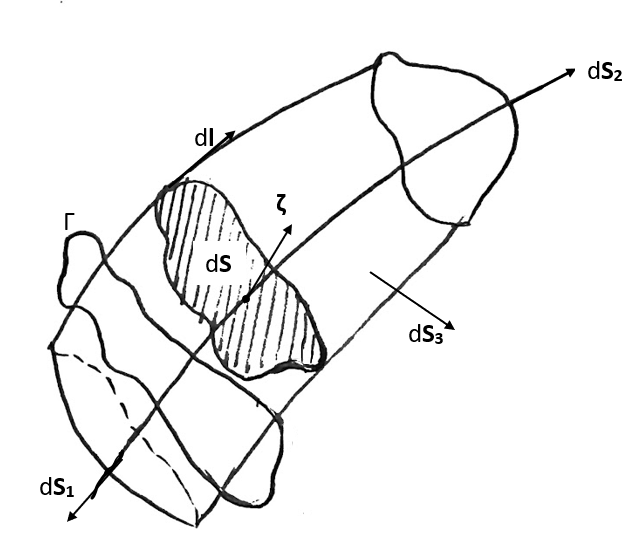Thermodynamics of Gas
aerodynamics, thermodynamics
Once we move from the molecular level to the macroscopic level (with the help of the continuum assumption), we need to define the properties of the fluid at a given point in space that give us the complete information about the gas. Minimum number of properties required to know the state of the gas are pressure \(p\), temperature \(T\), density \(\rho\) and the internal energy \(e\) of the gas at a given point in space. These are intrinsic properties of the gas.
However, we need to know only two of them given the caloric and thermal equations of state. The caloric equation of state relates pressure, temperature and density. The thermal equation of state relates temperature and internal energy.
Therefore the state of a gas is defined by any two quatities,
\[(p,T) \Leftrightarrow (p,\rho) \Leftrightarrow (T,\rho)\]
along with the equations of state: caloric equation of state and thermal equation of state.
Examples of caloric equation of state are
- Ideal gas equation
\[p = \rho RT\]
where, \(R\) is the gas constant.
- Van der Waals equation of state
\[p = \frac{\rho RT}{1-\frac{\rho b}{M}} - \frac{a\rho^2}{M^2}\]
where, \(a\) and \(b\) are constants and \(M\) is the molecular weight of the gas.
Examples of thermal equation of state are
- Ideal gas equation
\[e = C_v T\]
where, \(C_v\) is the specific heat at constant volume.
- Van der Waals equation of state
\[e = C_v T + \frac{a}{M} \frac{\rho}{1-\frac{\rho b}{M}}\]
where, \(a\) and \(b\) are constants and \(M\) is the molecular weight of the gas.
Now our fluid model is complete for a stationary gas. But for a fluid in motion, we also need its velocity \(\vec{U}= [u, v, w]\). So there are 5 unknowns to be found out.
Pleaes note that a moving fluid also generates stress because of viscosity. In order to calculate these, we need to know a method to calculate these stresses. These can be readily calculated using Newton’s law of viscosity. \[\tau = \mu \frac{\partial u}{\partial y}\]
where \(\mu\) is the coefficient of viscosity. Therefore, \(\mu\) should be known for the fluid along with its dependence on temperature and pressure. For incompressible flow \(\mu\) is a function of temperature only. For compressible flow, \(\mu\) is a function of temperature and pressure. The dependence of \(\mu\) on temperature is given by Sutherland’s law.
But for inviscid flow, we do not need to know the viscosity of the fluid.
In order to find these 5 unknowns, we start with the physical laws and express them in the form of mathematical models. The physical laws are:
Physical laws:
Mass is always conserved (Apart from Nuclear fusion/fission)
First law of thermodynamics ( Energy can neither be created nor destroyed. But can only be converted from one form to another.)
Newton’s second law [\(\vec{F}=\frac{d}{dt}(m\vec{v})\)] (also known as the equation of motion)
Conservation of mass (Continuity Equation)
The simplest statement of conservation of mass is
\[ mass = constant\]
Please go through any standard text book on fluid mechanics to understand the - Lagrangian framework - Eulerian framework in detail. It will be assumed hereonafter that the reader is familiar with these concepts.
But mass is not an intrinsic property of a fluid. So, I have to convert it into a function of state properties (p,T,\(\vec{U}\)). Therefore,
\[ {\large{\subset\!\supset}} \llap{\iiint}_{\cal{V}(t)} \,\rho \operatorname{d}V = const. \]
But, we don’t know the constant. So, we take a derivative to remove the constant.
\[ \frac{\operatorname{d}}{\operatorname{d}t} {\large{\subset\!\supset}} \llap{\iiint}_{\cal{V}(t)} \,\rho \operatorname{d}V = 0\]
This is a simply looking equation. But it is not very useful as we need to know \(\cal{V}(t)\), i.e. the langrangian control volume as a function time. Unfortunately, apart from some special cases, we cannot know \(\cal{V}(t)\) unless we know \(\vec{U}\) which we are trying to find out.
Therefore, we need the equations in the Eulerian control volume where the in the control volume will be fixed.
It is usually easier to apply the physical laws in the Lagrangian framework. But do not result in equations that are easy to solve. So we convert the equations to the Eulerian framework. For this purpose, we use the Reynolds Transport Theorem.
Now, Conservation of mass: \[\begin{aligned}
m &= const. \\
\frac{dm}{dt} &= 0 \\
\frac{d}{dt} {\large{\subset\!\supset}} \llap{\iiint}_{{\ooalign{\hfil$V$\hfil\cr\kern 0.08em--\hfil\cr}}(t)} \rho(\vec{r},t) d{\ooalign{\hfil$V$\hfil\cr\kern 0.08em--\hfil\cr}}&= 0 \\\end{aligned}\]
This is the integral form of conservation of mass. The issue is, this still does not gives us the flow properties inside a control volume. For that differential equations are required. Why differential form of equations?
Using Divergence Theorem, \[\begin{aligned}
{\large{\subset\!\supset}} \llap{\iiint}_{{\ooalign{\hfil$V$\hfil\cr\kern 0.08em--\hfil\cr}}} [\frac{\partial\rho}{\partial t} + \nabla.(\rho\vec{u})] d{\ooalign{\hfil$V$\hfil\cr\kern 0.08em--\hfil\cr}}&= 0\end{aligned}\] This is valid for any arbitrary volume.
This is the differential form of conservation of mass.
\[\begin{aligned}
\frac{\partial\rho}{\partial t} + \vec{u}.\nabla\rho +
\rho \nabla.\vec{u} &= 0 \\
\frac{D\rho}{Dt} + \rho \nabla.\vec{u} &= 0\end{aligned}\] This is another form. Also, write the incompressible flow equation.
Conservation of momentum:
Newton’s second law:
\[\begin{aligned}
\frac{d\vec{p}}{dt} &= \vec{F} \\\end{aligned}\] where, \(\vec{p}\) is momentum. Therefore, \[\begin{aligned}
\frac{d}{dt} \int_{{\ooalign{\hfil$V$\hfil\cr\kern 0.08em--\hfil\cr}}(t)} (\rho d{\ooalign{\hfil$V$\hfil\cr\kern 0.08em--\hfil\cr}}) \vec{u} &= \vec{F_s} + \vec{F_{{\ooalign{\hfil$V$\hfil\cr\kern 0.08em--\hfil\cr}}}} \end{aligned}\] where, \(\vec{F_s}\) is the surface force because of interaction of the volume with its surrounding and \(\vec{F_{{\ooalign{\hfil\)V\(\hfil\cr\kern 0.08em--\hfil\cr}}}}\) is the volume/body force (examples are gravity, electromagnetic forces). For inviscid conditions, shear force is ignored.
This is a vector equations with three components.
\[\begin{aligned}
{\large{\subset\!\supset}} \llap{\iiint}_{{\ooalign{\hfil$V$\hfil\cr\kern 0.08em--\hfil\cr}}} \frac{\partial(\rho.\vec{u})}{\partial t} d{\ooalign{\hfil$V$\hfil\cr\kern 0.08em--\hfil\cr}}+ {\subset\!\supset} \llap{\iint}_s \rho\vec{u}(\vec{u}.\vec{ds}) &= \vec{F_{surf.}} + {\large{\subset\!\supset}} \llap{\iiint}_{{\ooalign{\hfil$V$\hfil\cr\kern 0.08em--\hfil\cr}}} \rho d{\ooalign{\hfil$V$\hfil\cr\kern 0.08em--\hfil\cr}}\vec{g}\end{aligned}\] where \(\vec{F_{surf.}} = \vec{F_{viscous}} + \vec{F_{pressure}}\)
We cannot apply RTT here. There is also no need to apply it since we apply the Newton’s second law at a given instant. We are calculating the forces acting at that instant correctly by this equation. But we will not be able to calculate \(\frac{d\vec{F}}{dt}\) (if needed) accurately.
